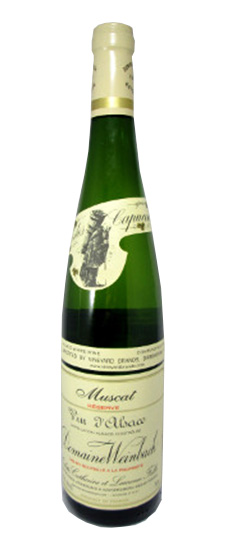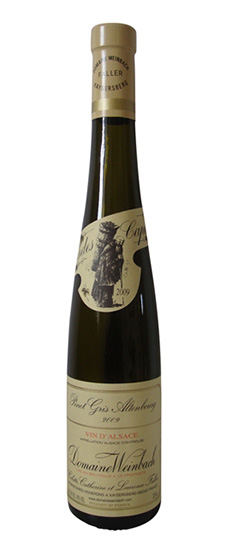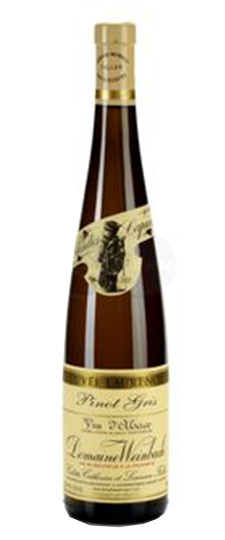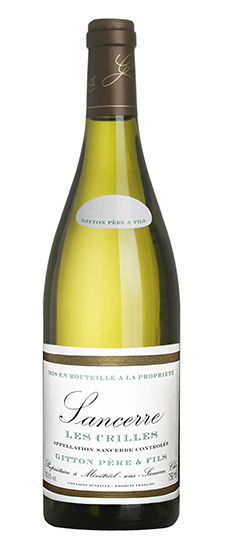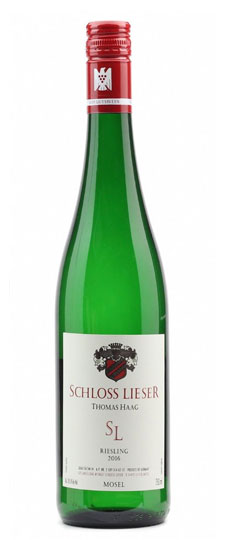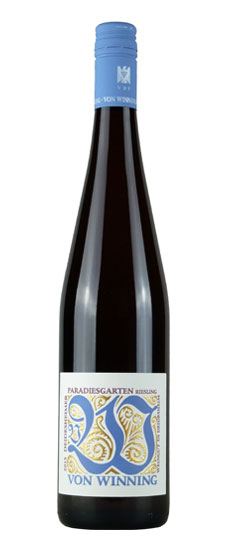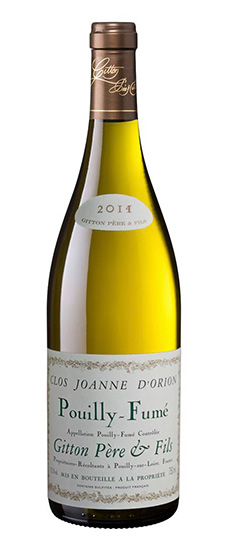Wine Score
The Wine Enthusiast – 90 pts
“White summer blossoms and ripe green pears make for a fresh scent. The palate lifts these notions with bright lemon acidity. All is buoyed by some residual carbon dioxide. Drink soon while this is at its aromatic height.” -Anne Krebiehl MW, Aug 2016
Grape Variety
Pinot Blanc Wine
Pinot Blanc is a versatile white-wine grape variety that is used in the production of still, sparkling and sweet dessert wines. Although not the most glamorous member of the Pinot family, the variety has proven its worth in various European wine regions, including Alsace in northeast France, the Alto Adige region of Italy, and in parts of Germany and Austria.
The variety is often regarded as Chardonnay’s understudy; like Chardonnay it produces a similar medium- to full-bodied style of wine with good acidity, and responds well to oak maturation. Pinot Blanc’s varietal characters include apple and almond, and sometimes a touch of smokiness, although – like Chardonnay – it is a palette for winemaker intervention, and flavors often depend on style.
Pinot Blanc Grapes
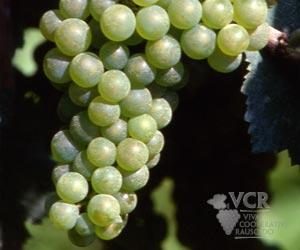 Pinot Blanc’s spiritual home is arguably Alsace, where it is overshadowed somewhat by the region’s undoubted stars, Riesling and Gewurztraminer. Pinot Blanc wines from the region are typified by almond aromas, with a hint of spice. On the palate they show a range of apple flavors, usually at the floury and creamy end of the spectrum. They may display some light mineral characteristics, but these are generally muted by the oak treatment favoured in the region. Sparkling Cremant d’Alsace wines, on the other hand, tend to be more crisp, often exhibiting a variety of nutty flavors.
Pinot Blanc’s spiritual home is arguably Alsace, where it is overshadowed somewhat by the region’s undoubted stars, Riesling and Gewurztraminer. Pinot Blanc wines from the region are typified by almond aromas, with a hint of spice. On the palate they show a range of apple flavors, usually at the floury and creamy end of the spectrum. They may display some light mineral characteristics, but these are generally muted by the oak treatment favoured in the region. Sparkling Cremant d’Alsace wines, on the other hand, tend to be more crisp, often exhibiting a variety of nutty flavors.
By a quirk of Alsace’s appellation laws, wines that are labeled as Pinot Blanc may in fact have an undisclosed proportion of Auxerrois, a similar grape variety which has slightly less acidity. Curiously, this rule does not apply to Auxerrois-labeled wines in Alsace.
In Burgundy, where the grape is thought to have originated, it is still permitted in many Grand Cru vineyards (although rarely makes its way into any of them). The variety is also one of the little-seen varieties permitted in the Champagne blend, playing second fiddle to Pinot Noir, Chardonnay and Pinot Meunier.
Outside of France, Pinot Blanc is planted widely in northwest Italy, where it is known as Pinot Bianco. Here, it is made in a lighter, crisper style that rarely sees any oak intervention, and is often blended with other varieties. Pinot Bianco is also used in the production of Italian sparkling wines: most notably Franciacorta, Italy’s answer to Champagne.
In Germany and Austria, the variety is known as Weissburgunder or Weisser Burgunder (literally “White Burgundy”). In Germany, its wines are usually light and refreshing, but in Austria, it can be used to make the luxuriously sweet and textured Trockenbeerenauslese. It was introduced here in the 19th Century and it is grown extensively in the eastern part of the country, particularly in Niederosterreich and Burgenland.
Pinot Blanc is also commercially produced in the United States, Canada, Argentina and Uruguay. Alcohol levels in these wines tend to be medium to high, with good acidity giving the wine a slightly sour, tart, edge. Pinot Blanc’s high natural acidity makes it a popular choice in the production of sparkling wine in California, while in Canada it can be made as ice wine. Canada’s Okanagan Valley has developed a reputation as a quality region for still Pinot Blanc production.
Synonyms include: Pinot Bianco, Weissburgunder, Weisser Burgunder, Beli Pinot, Klevner (Alsace), Blanc Vrai (Champagne)
Food matches for Pinot Blanc include:
- Quiche Lorraine
- Pad Thai noodles
- Grilled chicken with garlic and tahini sauce
Region
Alsace Wine
Alsace, in the far north-eastern corner of France, stands out from other French wine regions thanks to its strong Franco-Germanic influences. These are the result of the region having switched back and forth between German and French sovereignty in recent centuries – and are evident not only in Alsatian architecture and culture, but also in the wines.
The Alsace region lies between the Vosges mountains and the French border with Germany, marked by the Rhine river. A long, thin region, it measures 115 miles (185km) north to south and just 25 miles (40km) from east to west. The key viticultural areas here are all located on the lower hillsides of the Vosges, on slopes with east and south-easterly aspects.
Alsace
A February morning in Alsace
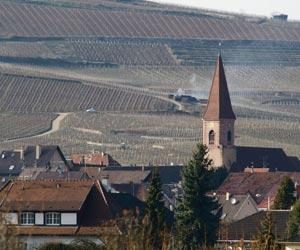 The Vosges play a vital role in defining the region’s terroir; they not only provide protection from the prevailing westerly winds, but also cast a rain shadow over the area, contributing to the low rainfall of its continental climate. They are at their most dense in the southern half of Alsace, where the peaks reach roughly 4600ft (1400m). The glacial activity which created the mountains has also significantly impacted the region’s topography and soils. These vary from sandstone, granite and volcanic rock types in the foothills, to clay-rich limestone and marlstone on the alluvial plains below.
The Vosges play a vital role in defining the region’s terroir; they not only provide protection from the prevailing westerly winds, but also cast a rain shadow over the area, contributing to the low rainfall of its continental climate. They are at their most dense in the southern half of Alsace, where the peaks reach roughly 4600ft (1400m). The glacial activity which created the mountains has also significantly impacted the region’s topography and soils. These vary from sandstone, granite and volcanic rock types in the foothills, to clay-rich limestone and marlstone on the alluvial plains below.
Alsace is the only French wine region to grow significant quantities of Riesling and Gewurztraminer. Both of these varieties are more commonly associated with German wines, and serve as a reminder of Alsace’s history. Pinot Gris, a variety typically marginalized in other French regions as a blending component, is another of the region’s specialties. Sylvaner and Muscat are also traditional Alsace grape varieties, as are Chasselas and Auxerrois although the latter two tend to be used not in single-variety wines but in blends (see Edelzwicker).
Alsace’s wines are produced under three key appellations: Alsace and Alsace Grand Cru for still white wines (both sweet and dry), and Cremant d’Alsace for sparkling. Almost all wine produced in this region fits into one of these three designations.
White varietal wines make up 90% of production here, from the varieties stated above. Key variations in wine styles are marked by their residual sugar levels, which cover the entire sweetness spectrum from bone dry to lusciously sweet. In 1983, the official terms Vendanges Tardives and Selection de Grains Nobles (see French Wine Label Information) were introduced to define and categorize sweet Alsace wines. They remained unique to the region for some time, but are now used in other French appellations such as Jurancon and Coteaux du Layon.
Although significantly outnumbered by white wines, red wines are also made here, mostly from Pinot Noir. Alsace Pinot Noirs are typically lighter-bodied and more rustic than those produced in the variety’s homeland Burgundy, 140 miles (225km) to the south-west. That said, climate change and warmer summers are leading the region’s winemakers to produce noticeably more powerful styles of Pinot Noir.
Dotted along the length of the region are 51 sites marked out as being of particular distinction; the Alsace Grand Cru vineyards.
Producer Notes
About Domaine Weinbach
Domaine Weinbach is a leading wine estate in the Alsace region. It is named after the “wine brook”, a small stream that runs through the main property, which is a former monastery near Kayserberg. The estate is known for its wines made at varying levels of sweetness from Riesling, Pinot Gris, Pinot Blanc, Sylvaner, Gewürztraminer and Muscat.
Domaine Weinbach
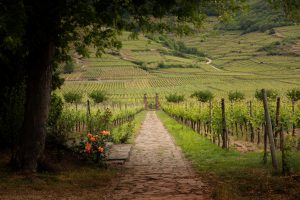 Unusually for the region, Weinbach only uses estate-grown grapes. It has holdings in four nearby Grand Cru vineyards on the slopes of the Weisbach Valley – Schlossberg, Furstentum, Mambourg and Marckgrain. Weinbach also owns the famous 5-hectare (12-acre) monopole, Le Clos des Capucins, which surrounds the cellars just below Schlossberg, and the Altenbourg vineyard adjacent to Furstentum.
Unusually for the region, Weinbach only uses estate-grown grapes. It has holdings in four nearby Grand Cru vineyards on the slopes of the Weisbach Valley – Schlossberg, Furstentum, Mambourg and Marckgrain. Weinbach also owns the famous 5-hectare (12-acre) monopole, Le Clos des Capucins, which surrounds the cellars just below Schlossberg, and the Altenbourg vineyard adjacent to Furstentum.
All of the estate’s 28ha (69 acres) of vineyards have been farmed biodynamically since 2005 and are certified by Ecocert and Demeter. After a gentle, gradual pressing, the juice is slowly fermented in old oak vats using indigenous yeasts.
For several decades the estate was run by Colette Faller and her daughters, winemaker Laurence and sales director Catherine. Laurence died tragically young from a heart attack in 2014, and her mother passed away the following year. Catherine Faller now runs the estate with her sons.

